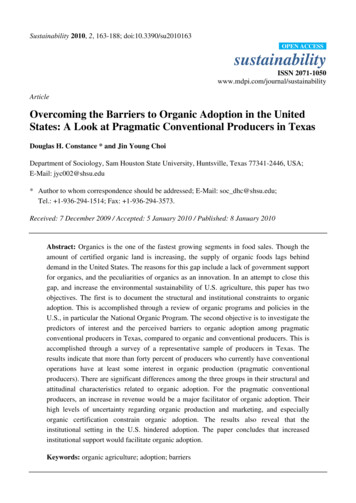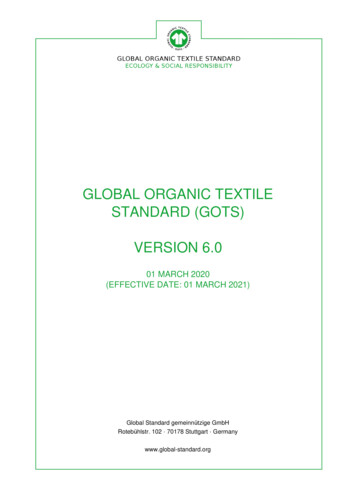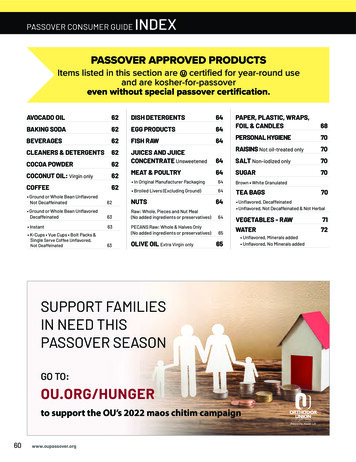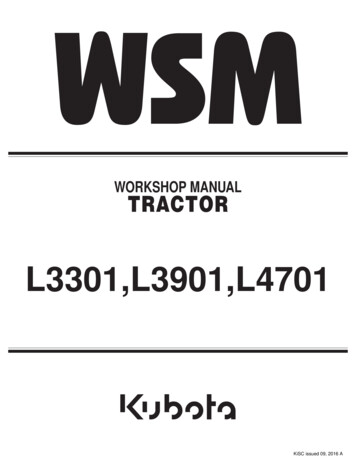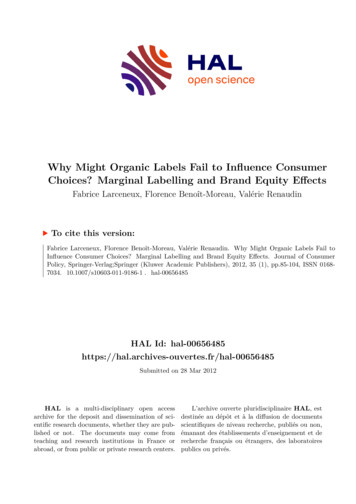
Transcription
Why Might Organic Labels Fail to Influence ConsumerChoices? Marginal Labelling and Brand Equity EffectsFabrice Larceneux, Florence Benoît-Moreau, Valérie RenaudinTo cite this version:Fabrice Larceneux, Florence Benoît-Moreau, Valérie Renaudin. Why Might Organic Labels Fail toInfluence Consumer Choices? Marginal Labelling and Brand Equity Effects. Journal of ConsumerPolicy, Springer-Verlag;Springer (Kluwer Academic Publishers), 2012, 35 (1), pp.85-104, ISSN 01687034. 10.1007/s10603-011-9186-1 . hal-00656485 HAL Id: 0656485Submitted on 28 Mar 2012HAL is a multi-disciplinary open accessarchive for the deposit and dissemination of scientific research documents, whether they are published or not. The documents may come fromteaching and research institutions in France orabroad, or from public or private research centers.L’archive ouverte pluridisciplinaire HAL, estdestinée au dépôt et à la diffusion de documentsscientifiques de niveau recherche, publiés ou non,émanant des établissements d’enseignement et derecherche français ou étrangers, des laboratoirespublics ou privés.
Larceneux, Benoit-Moreau & RenaudinJCP 2012J Consum PolicyDOI 10.1007/s10603-011-9186-1Fabrice Larceneux & Florence Benoit-Moreau & Valérie RenaudinF. Larceneux (*)Dauphine Recherches en Management (DRM, UMR 7088), Université Paris–Dauphine,Place du Maréchal de Lattre de Tassigny, 75775 Paris Cedex 16, Francee-mail: fabrice.larceneux@dauphine.frWhy Might Organic Labels Fail to Influence Consumer Choices?Marginal Labelling and Brand Equity EffectsAbstractAn organic label offers a market signal for producers of organic food products. In Westerneconomies, the label has gained high recognition, but organic food still represents a small partof total food consumption, which raises questions about the label’s efficacy. By consideringorganic labels a signal of quality for consumers, this article studies how this signal interactswith brand signals when both are visible to consumers, applying a cobranding framework.This research examines the moderating effect of the brand on organic label effects. In a 2 2experimental design using real consumers (n 122) in a shopping context, it found that,depending on brand equity, the marginal effect of organic labelling information in terms ofperceived product quality vary. In particular, when brand equity is high (low), the organiclabel appears less (more) effective. However, regardless of the brand equity level, an organiclabel makes the environmentally friendly attribute salient, which has a positive impact onperceived quality. Pertinent implications for marketing and public policy are discussed.Keywords Organic label, Brand equity, Label equity, Co-branding, Perceived quality,Environmentally friendly1
Larceneux, Benoit-Moreau & RenaudinJCP 2012Modern global challenges, such as climate change and public health crises, push publicauthorities to defend and improve the long-term collective welfare of the populations forwhich they are responsible. To achieve this goal, sustainable consumption can be a criticalcontributor and encourage sustainable growth (Heiskanen and Pantzar 1997). The 1994 OsloSymposium on sustainable consumption has established that the principles of democracy andthe reality of control limitations demand that changes in consumption patterns be achieved notby force (e.g., bans) but rather through responsible consumer choices (Scammon and Mayer1993) facilitated by the provision of independent information on markets. Because they allowfor freedom of choice and avoid distorting market prices (Pearce 1991), labelling practicestend to be a preferred option to attain various objectives; for example, nutrition labels servepublic health objectives (Mannell et al. 2006), and environmental labels aim to achieveecological goals (see Koos 2011). In the food sector, official organic labels attempt topromote the development of organic farming and more sustainable consumption (Thøgersen2000).Yet current consumption lifestyles remain largely unsustainable, and progress towardsustainable consumption has been slow (Thøgersen 2004). Increases in organic consumptionin many Western economies might have resulted from labelling strategies, but organic foodstill represents a small percentage of farming production in OECD countries (Hughner et al.2007) and of consumption (Thøgersen 2010). For example, 25 years after the creation of theofficial organic label AB, only 2% of the total food market in France is organic. Discussionsof labelling as a tool to encourage organic consumption thus require special attention to finaldemand-side aspects, that is, consumers’ point of view and the reasons consumers do not buy,or even intend to buy, organic products (Beckman 2005). We therefore adopt the consumerperspective and deliberately leave aside other aspects, such as supply conditions (e.g., amountof dedicated land, retail availability).Some research suggests that organic consumption might suffer from negative consumerperceptions, such as expensive perceived prices (Davies et al. 1995), lack of appeal (LataczLohmann and Foster 1997), poor trust in labels, or lack of perceived value (Makatouni 2002;We build on this latter argument: Strictly speaking, an organic label is a proof of certificationthat demonstrates compliance with specific requirements in production processes. But apartfrom a niche market of well-informed or concerned consumers, is what the label signalssufficient motivation to purchase more expensive products and thus to encourage sustainableconsumption? If so, what conditions might make labels more or less effective? Do officiallabels offer enough added value, compared with other signals, such as trade brands?2
Larceneux, Benoit-Moreau & RenaudinJCP 2012Furthermore, a more provocative approach to labels identifies them as cues to globalquality, rather than just proof of certification. Therefore, we explore how consumers mightinfer subjective quality beliefs from the label, in line with a halo effect. Accordingly, wefollow previous work that has shown that consumers often perceive organic products ashealthier, tastier, safer, and supportive of local economy (Hughner et al. 2007; Lodorfos andDennis 2008), as well as environmentally friendly. Zanolli and Naspetti (2002) find thathealth provides a primary consumption motive, even without proof that organic food is betterfor people’s health. By providing information about several product attributes, an organiclabel thus competes with or complements other signals (or cues, in marketing terminology;Grunert 2005)Therefore, this study makes several specific contributions. We consider how the contextin which labels appear influences consumers’ perceptions. As Thøgersen (2002) noted, ifother relevant information competes for the consumer's attention, consumers may easily failto notice relevant labels in the buying situation. In particular, we investigate the combinedeffect of two cues, the label and the trade brand, according to a cobranding theoreticalframework (Geylani et al. 2008; Janiszewski and Van Osselaer 2000; Park et al. 1996; Raoand Ruekert 1994; Rao et al. 1999). We investigate the marginal value of an organic label thatappears in combination with a brand, including whether that value varies for brands with highversus low equity. When a brand enjoys high brand equity, consumers feel confident that theyknow and can trust its product characteristics, so they may consider the organic label lessuseful.This question has both political and managerial implications. Before companies adoptlabelling strategies, they need assurance that the binding specifications will translate intoeffective commercial arguments and competitive advantage (Thøgersen 2002). Producers andretailers tend to adopt labelling strategies, which can be lengthy, costly, and difficult toreverse, only if they are expected to be profitable, especially compared with other signalingstrategies, such as developing their own brand strategy or using advertising levers (Golan etal. 2000; Thøgersen 2000). This issue is particularly critical for retail brands, because largeretail stores might provide effective sites for convincing people that choosing organicproducts is the best decision (Dytrtova 2008; Hofer 2000; Wier and Carlverley 2002). Wethus explore the differences between strategies that signal quality with just the brand andthose that add an official organic label. Do consumers perceive a significant difference? Isorganic labelling a profitable option?3
Larceneux, Benoit-Moreau & RenaudinJCP 2012Literature Review and HypothesesOrganic Labels as Signals of Product QualityFollowing an economic theoretical framework, public authorities allow producers to useorganic labels to reduce the information asymmetry that exists when a producer hasinformation about product quality that consumers lack. As Akerlof (1970) shows, if the sellercannot inform consumers of the superior quality of its product, it fails in the market, leavingonly poor quality products (i.e., “lemons”) available for purchase. To avoid this situation, theseller must bear a cost to signal its quality (Spence 1974): Labelling is an option for doing so.Good products are generally viewed as those with higher quality. But are they really?What does quality exactly mean? Following Grunert (2005), we differentiate an economicperspective, which focuses on the “market signal of quality” and its ability to conveyinformation about overall quality, from a marketing perspective, which explores theinferences that a consumer makes when confronted with an extrinsic cue to form judgments ofoverall quality and its dimensions. This differentiation echoes objective versus subjectivedimensions of quality. For example, as a form of certification, an organic label is an economicsignal, offering proof of objective quality because the product has been produced followingenvironmentally friendly requirements. From a consumer-oriented perspective though, thelabel offers a cue that generates varied associations (Carpenter and Larceneux 2008) to helpconsumers make evaluations of overall quality, assuming they understand and trust the label(Koos 2011; Sønderskov and Daugbjerg 2010; Thøgersen 2004). In France, organic labelrecognition and knowledge is not an issue: 97% of French consumers recognize the organiclabel “AB” (Opinion Way 2010) and 80% have eaten at least one organic product in 2011(Ifop 2011). Because the label is issued by official third parties and backed by governments, itshould be a well-trusted cue (Roosen et al. 2003). Even if the organic label is supposed toinform on environmental dimension, in line with various research (Golan et al. 2001; Nayga1999; Jahn et al. 2005), results are not clear about the real overall perceived quality.Following Van Doorn and Verhoef (2011), in the specific case of virtue products, i.e.wholesome and nourishing, we suppose that consumers likely use the organic label to inferpositively overall quality. As such, labelling policy would help to differentiate good from badproducts. We postulate:H1a: The presence of the organic label on a product positively influences consumers’perceptions of overall product quality.From Holbrook and Corfman’s (1985) and Zeithaml’s (1988) research, we know thatperceived overall quality represents the combination of consumers’ perceptions of attributes.4
Larceneux, Benoit-Moreau & RenaudinJCP 2012In food markets, Grunert et al. (1996) distinguish four attribute dimensions that determineconsumers’ product quality judgments: (1) sensory attributes, including taste, appearance, andsmell, though for food, taste is dominant (Lodorfos and Dennis 2008; Thomson et al. 1994);(2) health attributes (e.g., food safety, positive effects on health); (3) process attributes, whichassumes consumers’ interest in process specifications (Lodorfos and Dennis 2008); and (4)convenience. The organic label informs consumers about specific characteristics, which leadto descriptive beliefs, but it also indirectly tells them about other attributes by generatinginferential beliefs. Descriptive product beliefs derive from information provided by the cuesin the shopping environment (Fishbein and Azjen 1975), which prompt a recalibration of theoriginal information in more explicit terms (e.g., a “hand pressed” label on a bottle of winegenerates the belief that the wine has been produced using traditional methods). Theconsumer constructs a belief based on a clear correspondence between the source and attributeinformation. In the specific case of the organic label, and given that the consumer knows,understands, and trusts the label, it logically prompts the belief that the product is producedusing an environmentally friendly process, such as one without pesticides (Hughner et al.2007; Roddy et al. 1996; Soler et al. 2002; Squires et al. 2001; Wandel and Bugge 1997). Wethus predict:H1b: The presence of the organic label on a product makes consumers associate theproduct with descriptive belief of environmental friendliness.Beyond descriptive beliefs, inferential beliefs might arise (Grunert, 2005). These beliefsoccur through inferential processes (Van Birgelen et al. 2000), through an elaboration ofmeaning beyond that provided explicitly (Pinson 1986). Thus inferential beliefs are due tohalo effects (Broniarczyk and Alba 1994) based on strong mental inter-attribute associations(Johnson and Levin 1985; Kardes 1988). Attribute associations are also the basic cause of theso-called “magic bullet” effect (Roe et al. 1999). For example, in a qualitative study, Frenchpeople expressed their belief that organic salmon offered better quality in terms of taste andhealth (Beckman 2005), though neither of these benefits was certified by the label. Organicconsumption research similarly has found that the main motives for consuming organicproducts include perceptions of superior taste (Hughner et al. 2007; Magnusson et al. 2003;Roddy et al. 1996; Schifferstein and Oude Ophuis 1998; Wolf McGarry et al. 2009) andhealth concerns (Chinnici et al. 2002; Huang 1996; Hughner et al. 2007; Hutchins andGreenhalgh 1995; Mondelaers et al. 2009a; Schifferstein and Oude Ophuis 1998; Tregear etal. 1994; Wolf McGarry et al. 2009; Zanolli and Naspetti 2002), though these benefits havenot been proven (Hoefkens et al. 2009). Thus, we hypothesize:5
Larceneux, Benoit-Moreau & RenaudinJCP 2012H1c: The presence of the organic label on a product causes consumers to associatethe inferential beliefs of good taste (i) and reduced health risks (ii) with the product.Organic Labels as Signals of Quality in Competition with OthersLittle research has analyzed organic labels’ efficiency in context (Anders and Moeser 2008;Thøgersen 2002; Thomson 1998), though multiple cues might inform consumers aboutproduct quality, especially in food markets (Grunert 1995). Among the various extrinsic cues,brands are fundamental to the consumer evaluation process (Dawar and Parker 1994; Rao etal. 1999). From a signaling perspective, brands provide signals of unobservable quality (Raoand Ruekert 1994; Rao et al. 1999; Wernerfelt 1988) that might complement or compete withorganic labels in terms of their effects on product quality judgments (Gray-Lee et al. 1994).According to Koos (2011), research into the effect of a plurality of quality signals isdesperately needed to understand labels’ efficacy. This may contribute to the apparentcontradiction that, although organic labels have high credibility and can influence consumerperceptions (Erdem and Swait 1998; Thøgersen 2000), even the most environmentallyconscious consumers do not always choose products on the basis of their environmentalfeatures (Rokka and Uusitalo 2008; Thøgersen 2004; Thøgersen and Olander 2003).According to Hughner et al. (2007), a primary deterrent to their purchase is satisfaction withcurrent food sources. Consumers might buy a nonorganic, brand name product if that brandconveys high overall quality. Therefore, attitudes toward a product should depend on its brandand the level of brand equity it attains.Brand Equity and Label Equity: Cobranding and the Marginal Labelling Effect (MLE)Brand equity refers to “a set of brand assets and liabilities linked to a brand, its name andsymbol, that add to or subtract from the value provided by a product or service to a firmand/or to that firm's customers” (Aaker 1991, p. 15). Building brand equity requires marketingactions; higher spending on reputation creates a more credible signal of quality for consumers(Erdem and Swait 1998; Ippolito 1990; Rao and Ruekert 1994). Keller (1993) proposessplitting brand equity into two dimensions, brand awareness and brand image, where the latteris based on associations or clusters of beliefs associated with the brand (Geylani et al. 2008).As a global signal of quality, a brand also serves as a cue for evaluating or predictingperformance on a set of relevant attributes (Park et al. 1996), in parallel with the inferencemaking process for labels.We propose that third-party labels constitute specific types of brands that coverdifferent types of products that fit the required specifications. Similar to brand equity, we6
Larceneux, Benoit-Moreau & RenaudinJCP 2012define label equity (see also Carpenter and Larceneux 2008) as awareness and a set ofassociations or beliefs that provide a strong, sustainable, differentiated advantage, comparedwith that achieved by unlabeled products. In this perspective, when a brand adds an organiclabel to its product packaging, the result is a type of cobranding. In a brand alliance, “two ormore brand names are presented jointly to the consumer” (Rao et al. 1999, p. 259; Geylani etal. 2008); cobranding implies a physical integration of the two brands (Levin and Levin2000). The cobranding framework can apply to different kind of alliances, such as a commonpresence on a packaging, joint advertising or promotion campaigns, sponsorship of sportsactivities, and so on (Lebar et al. 2005). It also can encompass the joint presence of a tradebrand and an official label.Cobranding aims to enhance both brands’ equity through affect or association transfers(Kim et al. 1996, 1998), because “two brand names may provide greater assurance aboutproduct quality than one alone” (Park et al. 1996, p.454). However, brand equity transfersoccur mainly when an individual brand cannot signal quality by itself (Rao and Ruekert1994). Several research works examine cobranding efficiency (Geylani et al. 2008;Janiszewski and Van Osselaer 2000; Park et al. 1996). For example, Janiszewski and VanOsselaer (2000) demonstrate that two brand names compete (or interact) to predict productperformance, rather than acquiring predictive value independently; that is, they do notnecessarily join forces but can be redundant or detrimental. Park et al. (1996) demonstrate thatcobranding by two favorably evaluated brands does not lead to a more favorably evaluatedcobranded product, because of their redundancy and probably a ceiling effect. Therefore abrand with high equity has less to gain from an association with an organic label than onewith less brand equity. Similarly, Mondelaers et al. (2009a) show that consumers preferorganic products over weak branded products but not over strong branded products. Thus, theeffect of the organic label should depend on the equity of the associated brand, and it is moreaccurate to consider the marginal effect of the label (MLE), in addition to the brand, toestimate the usefulness of environmental labelling for a branded product. Hence, wehypothesize:H2a: The impact of an organic label on perceived overall product quality is weakerwhen the original brand has high rather than low brand equity.At the attribute level, Park et al. (1996) demonstrate the importance of brands’complementarity for effective alliances. Brands are complementary when they have acommon set of relevant attributes but differ in their attribute salience or performance. In thiscase, consumers tend to align their evaluation of the attributes of the cobranded product with7
Larceneux, Benoit-Moreau & RenaudinJCP 2012the most salient or highest performing partner. Therefore, brands truly join forces, through thealignment of the overall score with the top performer’s evaluation. When two brands areevaluated favorably on the same attributes though, they offer redundant predictiveinformation and are inefficient as cobranding partners: They would obtain the sameevaluation even in a standalone scenario. Applying this reasoning, we predict that a brandwith high brand equity triggers an image of high quality and stronger, more numerousassociations. Central food associations, such as good taste and lower health risk, should bemore salient and better evaluated for high equity brands. Then through the halo effect(Leuthesser et al. 1995), inferential beliefs such as environmentally friendly may also increasefor a high equity brand compared with a low equity one. The complementarity between thelabel and the low equity brand in turn should be greater than that for the high equity brand andenhance perceptions of product attributes (good taste, reduced health risk, environmentalfriendliness) more. We hypothesize then thatH2b: The impact of the organic label on the strength of a descriptive belief aboutenvironmental friendliness is weaker when the original brand has high rather thanlow brand equity.H2c: The impact of the organic label on the strength of the inferential beliefs aboutgood taste (i) and reduced health risk (ii) is weaker when the original brand has highrather than low brand equity.Reinforcing the Salience of Environment Friendliness for Product Quality JudgmentsEven if consumers express environmental concerns (Alwitt and Pitts 1996), environmentallyfriendly features may remain peripheral if there is no personal threat (Thøgersen 2000),because they will not be integrated into the overall quality assessments in normal foodproduct evaluations. Because of its associations with benefits such as taste, health, andconcern for the environment (Hughner et al. 2007), the presence of an organic label shouldactivate corresponding cues and make these attribute more salient to judgments of overallproduct quality.According to the accessibility–diagnosticity model (Feldman and Lynch 1988; Herr et al.1991), the likelihood that a piece of information is used as an input to a judgment depends onthe accessibility and diagnosticity of this input, compared with that of alternative inputs.Considering its salience for the organic label, the environmentally friendly attribute becomesmore accessible. The organic label, as a credible and certified quality signal, also should boostconsumers’ confidence in the information, which assures its diagnosticity of this attribute. Wehypothesize:8
Larceneux, Benoit-Moreau & RenaudinJCP 2012H3: An organic label significantly increases the influence of the environmentallyfriendly attribute in consumers’ judgments of overall product quality.Field Study MethodologyTo test the different hypotheses, we conducted a between-subjects 2 2 experiment in whichwe manipulated brand equity (high versus low) and the labelling strategy (no label versusorganic label).Product and Brand ManipulationsBecause realism is required for research on environmentally friendly choices (Rokka andUusitalo 2008), we did our best to approximate real purchase conditions. Similar to Rao et al.(1999), we conducted our experiment near the checkouts of Monoprix retail stores. Inaddition, we manipulated differences in brand equity by using existing brands that, at the timeof the study, used an organic labelling strategy. Based on observations in five retail storesacross different product categories, we chose smoked salmon as the test category for severalreasons. Salmon is an interesting case of organic food because consumers’ demands might atleast partly explain the development of salmon farming (Beckman 2005). In France, thisproduct category includes a wide variety of positioning tactics (costs range from 3 to 10 )and quality levels, and various brands and labels appear on shelves. Furthermore, taste, healthand environmental issues are dimensions French consumers evoke when they assess quality oforganic salmon (Beckman 2005). Although salmon was once a product consumed only onspecial occasions, it has become quite inexpensive and far more common.In our experiment, 122 adult customers evaluated a salmon packaging, recruited rightafter they completed a checkout at a Monoprix store. We kept only salmon buyers whobought salmon at least once in the past year. They viewed one of four versions of our studystimuli, then answered a short questionnaire that contained the dependent variables. Thesestimuli featured full-scale, color copies of the original packaging of two real brands sold inthe store (Labeyrie and Monoprix private label), each with an added organic label or not (seeAppendix 1). Each respondent was randomly assigned to one of the four conditions(Appendix 2).The low equity brand was the Monoprix private label "M"; this brand covers a widerange of products with mainstream positioning in terms of price, quality, and product features.Brand equity research often uses mainstream private labels as benchmarks to measure anational brand’s equity (Kamakura and Russel 1993), and Grunert (2005) has noted that “the9
Larceneux, Benoit-Moreau & RenaudinJCP 2012lack of a brand history and the historical association of retailer brands with generic and lowprice products results in consumers taking a retail brand as a cue indicating low rather thanhigh quality.” Monoprix also is a good setting for this study because its private brandencompasses many products. For the high equity brand, we used the leading national brand,"Labeyrie". Neither brand had adopted a specific positioning in relation to a natural orenvironmentally friendly image.Dependent VariablesWe evaluated both perceived overall quality and three potential components of overallquality: an environmentally friendly process of production, perceived good taste, andperceived health risk. For the four dependent variables, we used single-item instruments onseven-point scales ranging from “fully agree” to “fully disagree.” Respondents thusconsidered the following question: “Please indicate your degree of agreement with thefollowing assertions: (1) This smoked salmon is of high quality, (2) This smoked salmonseems to have a better taste than others, (3) Eating this smoked salmon could carry a risk formy health, and (4) This smoked salmon seems to have been bred following anenvironmentally friendly process.” We controlled for sociodemographic variables, purchasefrequency in the product category, and frequency of store visits.ResultsManipulation CheckTo assess differences in perceived brand equity, we used price image, a traditional aggregatemeasure that assumes a brand with high equity can charge a price premium, all else beingequal (Lassar et al. 1995). We employed two questions to determine an appropriate pricerange: “Below what price would you not buy this product?” and “At what price do youconsider that this product is being sold at an excessive price?” The wide price range of 3 to10 corresponded with actual prices in the store. Price image constitutes the averageresponses to these two questions, and our manipulation was successful: The image of theproduct price for the low equity brand (M 2.6) was significantly lower than that for the highequity brand (M 4.1; t(12) 4.9, p .001).Control Variables and Descriptive StatisticsGender ( ²(3) 4.0, ns), age ( ²(9) 10.6, ns), and familiarity with the label ( ²(3) 5.6, ns)are equally distributed across groups, but purchase frequency is not ( ²(3) 14.8, p . 002).10
Larceneux, Benoit-Moreau & RenaudinJCP 2012Our filter question excluded any consumers who never bought salmon. We include thisvariable in our analysis to control for its effect. In our sample, 30% of the respondents weremen; 24% were younger than 25 years, 60% between 26 and 60 years, and 15% were olderthan 60 years. The descriptive statistics (means and standard deviations) for the twoconditions are in Table 1.[Table 1 here]Tests of H1: Organic Label as a Signal of QualityIn order to study the signaling effect of the organic label, a one way Anova is run withthe perception on overall product quality as the dependent variable. As expected, we find asignificant main effect of the label on overall product quality F(1, 120) 7.8, p .007), insupport of H1a. Test of means differences showed that the non-labelled product was ratedsignificantly lower in quality (m 4.7) than the organic labelled product (m 5.5). As H1a issupported, we conclude that consumers use this specific cue to infer a better overall quality:they identify "good" products by means of an organic label.11
Larceneux, Benoit-Moreau & RenaudinJCP 2012H1b and H1c suggest this label generates descriptive beliefs on environmentally friendlyprocess and inferential beliefs on good taste and health risk. In order to test this impact onseveral correlated (the correlation between items such as good taste *environment friendly is r .50.) dependent measures simultaneously, a multivariate analysis of variance (Manova) isused (Hair et al. 1995), with label and brand as independent categorical variables. Asignificant Box's M test indicates an equality of variance/covariance matrices of the multipledependent variables across treatment groups. Non-significant Levene tests for each singledependent variable further confirm this condition.A one way Manova on the three beliefs is significant (F(2, 116) 8.7, p .001). Results reveal astrong main effect of the organic label on the descriptive belief regarding environmental caretaken during production (F(1, 118) 24.8, p .001). Labelled products are rated moreenvironme
abroad, or from public or private research centers. L'archive ouverte pluridisciplinaire HAL, est destinée au dépôt et à la diffusion de documents scientifiques de niveau recherche, publiés ou non, émanant des établissements d'enseignement et de recherche français ou étrangers, des laboratoires publics ou privés.



